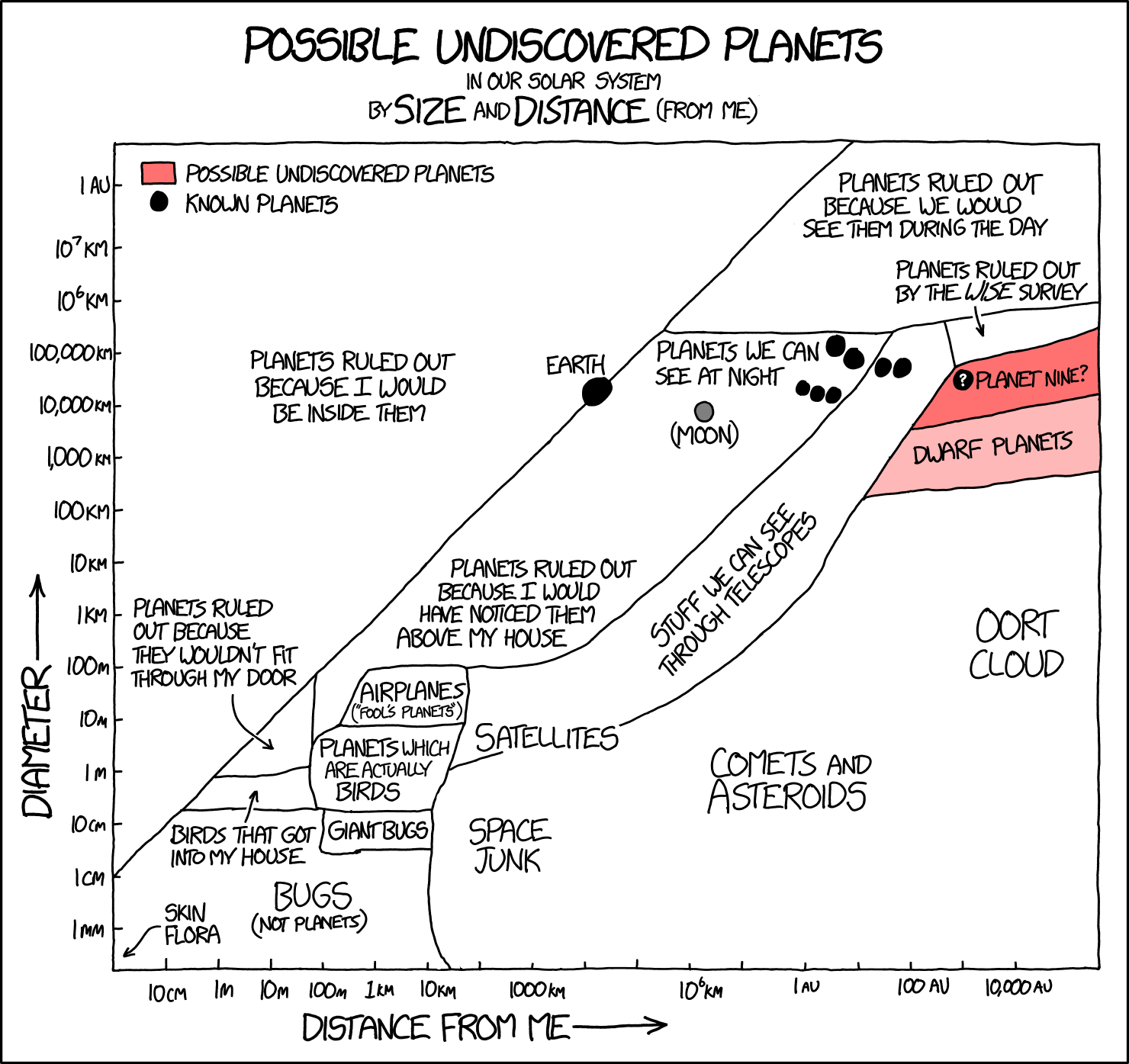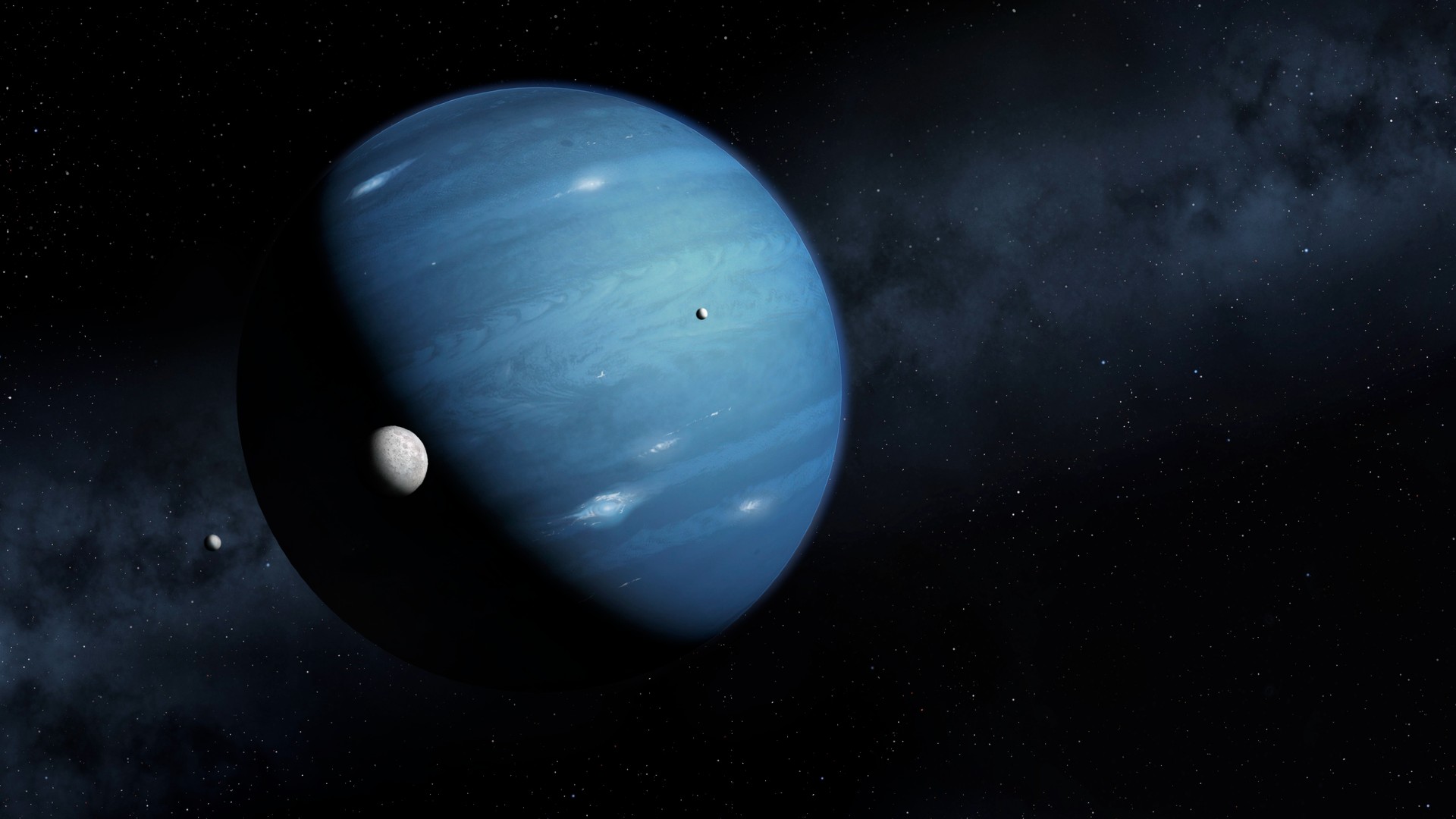My WAG is Earth sized, but not Neptune. Earth sized would be pretty big. Mercury sized?

My WAG is Earth sized, but not Neptune. Earth sized would be pretty big. Mercury sized?
It does to an extent, unless it’s either behind or in front of Pluto from our vantage point. However, it’s smaller than Pluto and has a lower albedo, so it’s not a big effect.
Depends on how far away it is.
Could a Jupiter-sized object 90% of the way to the inner boundary of the Oort Cloud cause perturbations in Neptune’s orbit that would fall into the margin of error for our current calculations of said orbit?
Also depends on the albedo. That is, how much of the Sun’s light it reflects.
Could a Jupiter-sized object 90% of the way to the inner boundary of the Oort Cloud cause perturbations in Neptune’s orbit that would fall into the margin of error for our current calculations of said orbit?
Neptune is about 30 AU from the sun and Jupiter about 5 AU. Therefore the minimum distance between Neptune and Jupiter is a out 25 AU. The very closest estimates for the inner edge of the Oort cloud us 2,000 to 5,000 AU. Let’s call the distance to Planet Nine 2025 AU for simplicity. So a Jupiter-sized object near the inner edge of the Oort cloud is 80 times further away from Neptune than Jupiter is. Gravitational attraction falls by the inverse square of distance. So that Planet Nine would have 1/6,400th the influence on Neptune that Jupiter has.
Could a Jupiter-sized object 90% of the way to the inner boundary of the Oort Cloud cause perturbations in Neptune’s orbit that would fall into the margin of error for our current calculations of said orbit?
We can’t even completely rule out the possibility of a small star out that far.
We can’t even completely rule out the possibility of a small star out that far.
A dim star or even a white dwarf companion within the Hills (inner Oort) cloud would likely be visible in the radio spectrum at least even if its higher frequency emissions were dimmed through its own opacity or an accumulated dust cloud, but a super-Jovian planet or a brown dwarf are entirely possible even at a few hundred AU of distance, and is exactly what statistical analysis of the perturbations of known TNOs are looking to find. A weekly radiating object like a protostar or very marginal white dwarf in the outer Oort cloud (the sphere of objects loosely bound to the Sun going out to as much as 200k AU) might not be seen just because we aren’t searching for it.
Regardless of albedo, the amount of sunlight being reflected beyond the outer boundary of the Kuiper Belt (>50 AU) is so little (<0.04% of that at Earth’s orbit) that finding even a high albedo object in solar orbit is mostly luck of finding a pattern of slightly-brighter than background spots in time series data that fit into an orbit although observations from high altitude and orbital observatories and the use of machine learning algorithms to find such patterns has improved the odds considerably. Larger dim bodies at that distance or greater might well be completely hidden from visible and near visible spectrum observation but still be sufficiently bound to the Sun to be in a loose elliptical orbits that would be considered a planet, either migrated out from the inner system during the initial reassortment of the planets or captured later as a wandering ‘rogue’ planet.
Stranger
And speaking of rogue planets, even if we did find such an object, it would be extremely difficult to prove that it was gravitationally bound to the Sun, and not a rogue just passing through.
Well that settles it. Munroe FTW.
The hover-over on that episode is:
Superman lies near the bird/plane boundary over a range of distances, which explains the confusion.
This deserves to be included in this thread since it discusses confusion near a boundary case which pretty well describes what Pluto or Pluto+Charon were / are.
Well that settles it. Munroe FTW.
Anything that goes from “skin flora” to “the Oort Cloud” in one diagram wins. ![]()

If the object really is Planet Nine, it would be larger than Neptune and exist 700 times further from the sun than Earth.
The Infrared Astronomy Satellite, IRAS, launched in 1983 and surveyed the universe for almost a year before being decommissioned. Then, in 2006, the Japanese Aerospace Exploration Agency (JAXA) launched AKARI, another infrared astronomy satellite that was active between 2006 and 2011.
700 AU would put it very close to where Monroe put his dot for a Planet 9. But Neptune size would lift it farther up.
Mike Brown says that if this planet exists, it wouldn’t account for the unusual scattering of Kuiper Belt objects out there. He’s not saying this planet doesn’t exist, just that it would upset his theory about a different ultra-distant planet that would account for the scattering.
I haven’t reread this thread, but I was curious about how far 700 AU is. Pluto’s average is 39.5 AU. The farthest known object from the sun is 2018 AG37. It is about 400 kilometers in diameter and 132 AU away. In terms of Munroe’s diagram, 2018 AG37 is a dwarf planet near the dwarf planet/Oort Cloud border, far away from the “Stuff we can see through telescopes” zone. (No worries, Munroe was presumably thinking generally: world records are by definition outliers.) Planet 9 would be about 5.3 times further away than 2018 AG37.
Among binary star systems, Alpha Centuri and Proxima Centuri are 15,000 AU away from each other. Binary systems can contain stars as far as one light year away from each other or 63,241 AU.
I understand that stars revolve around a galactic core, so gravitational effects can persist across very long distances. (Not all galaxies have galactic cores though; many do not.) Learned clarifications welcome.
The farthest known object from the sun is 2018 AG37. It is about 400 kilometers in diameter and 132 AU away. In terms of Munroe’s diagram, 2018 AG37 is a dwarf planet near the dwarf planet/Oort Cloud border, far away from the “Stuff we can see through telescopes” zone.
Your article doesnt call it a dwarf planets, and at 400 KM it would be very small. 120347 Salacia is twice that size and it is considered to be a borderline case.
But it is interesting how "farout’ we can spot these things.
Article:
Farfarout is very faint, and based on its brightness and distance from the Sun, the team estimates its size to be about 400 kilometers across, putting it on the low end of being a dwarf planet assuming it is an ice-rich object.
But I agree 2018 AG37 (aka Farfarout) is borderline, and my characterization went through a couple of drafts. It’s not on the list compiled by wiki, and I see the Pluto-hating IAU bestowed dwarf planet status on a limited number of objects. It appears to be in Munroe’s dwarf planet zone, FWIW, but I retract my planetary characterization of Farfarout.
so gravitational effects can persist across very long distances.
Gravitation works across arbitrarily large distances. It is the force that doesn’t quit.
Lack of a distinct core doesn’t really matter for galactic rotation. Every part of the galaxy is acting every other part. Or perhaps better put, the path each object takes is dictated by the contribution of every other object’s gravity. Our sun roughly orbits a point that is the centre of mass of the galaxy. The more diffuse the mass in the galaxy is, the more messy this becomes to define. A galaxy doesn’t really need a specially dense core region. Everything remains gravitationally bound to everything else and will all rotate together.
Just how it all rotates and what the distribution of mass implied by that rotation is, is what brought us to the puzzle of dark matter.